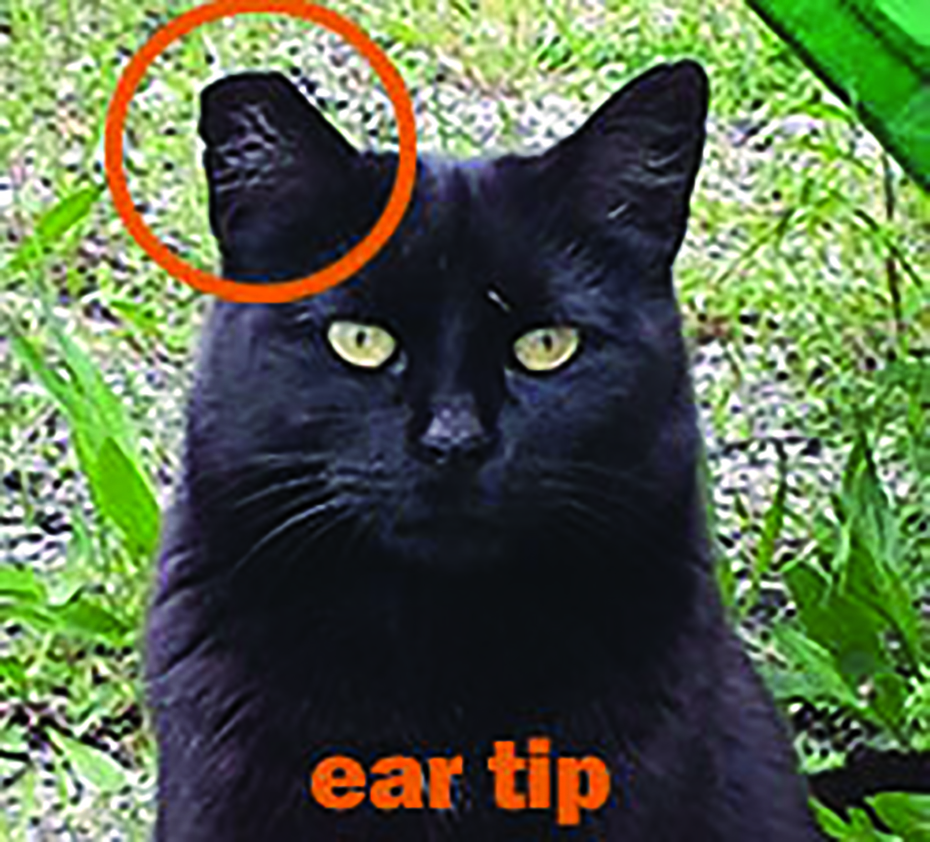
A feral cat that has one ear slightly shorter with a flat top has been ear tipped. This is done to identify that the cat has been spayed or neutered and is therefore free to roam. Photo courtesy of the Feral Cat Spay/Neuter Project.
By: Lydia Crawley
The Parsons Advocate
The Tucker County Animal Shelter is offering free spay/neuter services for cats in Tucker County Animal Shelter Director Stacey Canfield updated the Tucker County Commission on the project at the Commission’s Thursday, June 13th meeting. “We have officially partnered up with SNIP out of Morgantown, West Virginia,” Canfield said. “And once a month they will be doing free spay and neuter services for owned cats in Tucker County.”
Canfield said that the first date of June 26th will be reserved for TNR (Trap Neuter Release) cats. Cats eligible for the first spay/neuter clinic interlude feral and farm cats, according to Canfield.“This first month, the 26th, its strictly for TNR, so your Trap Neuter Releases, your feral cats that can never be tamed and can never be adopted out, your farming cats, things like that,” Canfield said.
According to Canfield, there are still spots available for the TNR day on the 26th. “We have 15 spots open, we filled six of them,” Canfield said. “So we still have a little bit of availability.”
Canfield said the program can accommodate up to 50 cats a month on clinic day. Canfield also said that she hopes a lot of people take advantage of the program so that it can continue into the future. “And depending on how much interest we get, we can go up to 50 cats a month in one day,” Canfield said. “So we are really hoping to see that get completely filled so that they keep wanting to help us.”
Canfield said her department is forced to partner with outside resources due to the lack of a veterinarian in Tucker County. “We are partnering up with outside resources because we don’t have a vet in the county and it is at least $130 for every animal just to spay and neuter that doesn’t even include vaccines and things like that,” Canfield said.
Due to the lack of a veterinarian in Tucker County, Canfield said her staff have began to offer Rabies Vaccinations and Microchip insertion at the Shelter. The service is offered to the public. “We are offering Rabies Vaccines and Microchipping at the shelter now to help out,” Canfield said.
The Shelter staff have been offering home vaccination visits to those with hunting dogs, Canfield said. “We’ve been on several home calls where we have gone out and vaccinated hunting dogs on property so you don’t have to load them up and bring them in,” Canfield said.
Canfield said her office will also do house visits to vaccinate aggressive and reactive animals for owners. “You know, you’re scared, aggressive, reactive cats, dogs, we’ll come to you and do that call so that you won’t have to worry about that,” Canfield said.
According to Canfield, the ordinance is written to protect animals such as cats that thrive outdoors. Canfield said that cats that have been ear tipped have already been spayed or neutered, but if a cat does not have an ear tipped, it likely is not spayed or neutered and should be taken to the Shelter. Cats that are already ear tipped are allowed to be where they are found, according to Canfield. “If you see a cat outside that is ear tipped, you don’t touch it,” Canfield said. “If you trap a cat that is not ear tipped, you bring it to us.”
Canfield said that cats that have been spayed or neutered are not as aggressive or adding to the feline population in the wild. “If a cat is ear tipped, it is not mating, it is not fighting, they’re not spraying on property,” Candfield said.
According to Canfield, even owned animals can be subject to the TNR ordinance. Canfield said any report to her office of a nuisance cat, even if it is owned, that does not have an ear tipped, is subject to TNR by local law. “So, anytime we get a feline nuisance complaint that a cat is not ear tipped, immediately bring it to us, let us fix it and we will immediately release it back,” Canfield said. “Because even if that was someone’s owned cat, it was running at large without an ear tip which falls under our community ordinance so legally we have to trap, neuter and release that animal.”
Canfield said the only responsibility the person who files the complaint has is to watch the trap and notify her office when the cat has been captured. According to Canfield, the Shelter staff will take care of everything else. “We’ll come set it, you just need to let us know when something goes in it,” Canfield said.
Canfield said to identify a cat that has been ear tipped, look for one ear that is flat at the top where the top part of the ear has been surgically removed.



